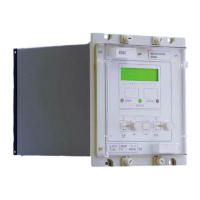VCG202/EN M/H11
Technical
The relay incorporates an initial time delay before the initiation of a tap change sequence.
On expiration of the time delay the appropriate ‘Raise Volts’ or ‘Lower Volts’ output relay
operates to control the tap changer. The initial time delay is the time delay to initiate the
first tap change step in a multiple sequence. Further tap change steps can then be
initiated by a fixed delay setting defined as the ‘Inter tap delay’.
4.4.3.1 Initial delay (tINIT)
The initial Delay timer is an integrating type and so it resets at a rate equal to the rate at
which it times out. This ensures that a tap change sequence is initiated when the mean
system voltage remains outside the deadband for the set initial delay. The timer resets
instantaneously if the voltage is swung through the deadband setting from one side to the
other.
4.4.3.2 Definite/Inverse time characteristics
The time delay to initiate a tap change sequence may have either a definite or inverse
time characteristic selectable by control link CTL1. Selection of a ‘Definite’ initial time
delay provides a fixed, definite time delay before initiating a tap change and is
independent of the voltage deviation. Whereas, selection of an ‘Inverse’ characteristic
gives the initial time delay as follows: -
The general expression for the inverse time curve is:
t = k + [(initial time delay setting) x (1/N)]
where:
k = 0.5 for initial time delay setting ≤20s
k = 0 for initial time delay setting >20s
N indicates deviation from Vs in multiples of dVs % and is calculated as:
N =
(Vreg - Vs)
dVs
where:
Vreg = Voltage to be regulated
Vs = Voltage setting (90 to 139V in 0.1V steps)
dVs = Dead band (±0.5% to ±20% of Vs in 0.1% steps)
Indication of how long the tap delay timer has to run before the next tap change can be
displayed on the LCD display.
An inverse characteristic reduces the response time of a tap changer to correct large
voltage deviations thus reducing the risk of damage to consumer’s equipment. For higher
voltage systems and for transformers where large voltage deviations are envisaged, the
inverse characteristic is preferred. The definite time delay is predominantly used on low
voltage distribution transformers.
Figure 5: Inverse time or definite time delay prior to tap change initiation

